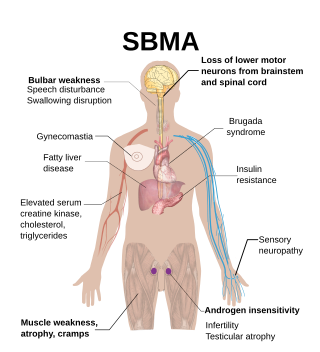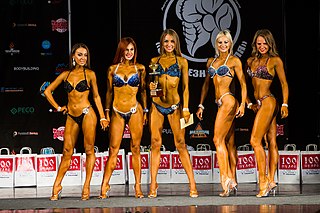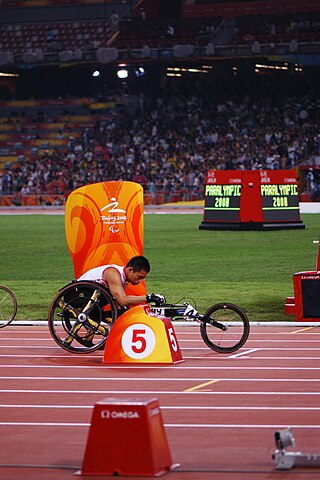
Bodybuilding is the practice of progressive resistance exercise to build, control, and develop one's muscles via hypertrophy. An individual who engages in this activity is referred to as a bodybuilder. It is primarily undertaken for aesthetic purposes over functional ones, distinguishing it from similar activities such as powerlifting and calisthenics.

Charcot–Marie–Tooth disease (CMT) is a hereditary motor and sensory neuropathy of the peripheral nervous system characterized by progressive loss of muscle tissue and touch sensation across various parts of the body. This disease is the most commonly inherited neurological disorder, affecting about one in 2,500 people. It is named after those who classically described it: the Frenchman Jean-Martin Charcot (1825–1893), his pupil Pierre Marie (1853–1940), and the Briton Howard Henry Tooth (1856–1925).

Muscular dystrophies (MD) are a genetically and clinically heterogeneous group of rare neuromuscular diseases that cause progressive weakness and breakdown of skeletal muscles over time. The disorders differ as to which muscles are primarily affected, the degree of weakness, how fast they worsen, and when symptoms begin. Some types are also associated with problems in other organs.

The ulnar nerve is a nerve that runs near the ulna, one of the two long bones in the forearm. The ulnar collateral ligament of elbow joint is in relation with the ulnar nerve. The nerve is the largest in the human body unprotected by muscle or bone, so injury is common. This nerve is directly connected to the little finger, and the adjacent half of the ring finger, innervating the palmar aspect of these fingers, including both front and back of the tips, perhaps as far back as the fingernail beds.

Torticollis, also known as wry neck, is a painful, dystonic condition defined by an abnormal, asymmetrical head or neck position, which may be due to a variety of causes. The term torticollis is derived from the Latin words tortus, meaning "twisted", and collum, meaning "neck".

Limb–girdle muscular dystrophy (LGMD) is a genetically heterogeneous group of rare muscular dystrophies that share a set of clinical characteristics. It is characterised by progressive muscle wasting which affects predominantly hip and shoulder muscles. LGMD usually has an autosomal pattern of inheritance. It currently has no known cure or treatment.

Beverley "Bev" Francis is an Australian gym owner and retired professional bodybuilder, powerlifter, and national shot put champion.

Duchenne muscular dystrophy (DMD) is a severe type of muscular dystrophy predominantly affecting boys. The onset of muscle weakness typically begins around age four, with rapid progression. Initially, muscle loss occurs in the thighs and pelvis, extending to the arms, which can lead to difficulties in standing up. By the age of 12, most individuals with Duchenne muscular dystrophy are unable to walk. Affected muscles may appear larger due to an increase in fat content, and scoliosis is common. Some individuals may experience intellectual disability, and females carrying a single copy of the mutated gene may show mild symptoms.
In medicine, myopathy is a disease of the muscle in which the muscle fibers do not function properly. Myopathy means muscle disease. This meaning implies that the primary defect is within the muscle, as opposed to the nerves or elsewhere.
Aerobic conditioning is the use of continuous, rhythmic movement of large muscle groups to strengthen the heart and lungs. Improvement in aerobic conditioning occurs when athletes expose themselves to an increase in oxygen uptake and metabolism, but to keep this level of aerobic conditioning, the athletes must keep or progressively increase their training to increase their aerobic conditioning.

Grip strength is the force applied by the hand to pull on or suspend from objects and is a specific part of hand strength. Optimum-sized objects permit the hand to wrap around a cylindrical shape with a diameter from one to three inches. Stair rails are an example of where shape and diameter are critical for proper grip in case of a fall. Other grip strengths that have been studied are the hammer and other hand tools. In applications of grip strength, the wrist must be in a neutral position to avoid developing cumulative trauma disorders.

Equine conformation evaluates a horse's bone structure, musculature, and its body proportions in relation to each other. Undesirable conformation can limit the ability to perform a specific task. Although there are several faults with universal disadvantages, a horse's conformation is usually judged by what its intended use may be. Thus "form to function" is one of the first set of traits considered in judging conformation. A horse with poor form for a Grand Prix show jumper could have excellent conformation for a World Champion cutting horse, or to be a champion draft horse. Every horse has good and bad points of its conformation and many horses excel even with conformation faults.

Spinal and bulbar muscular atrophy (SBMA), popularly known as Kennedy's disease, is a rare, adult-onset, X-linked recessive lower motor neuron disease caused by trinucleotide CAG repeat expansions in exon 1 of the androgen receptor (AR) gene, which results in both loss of AR function and toxic gain of function.

Fitness and figure competition is a class of physique-exhibition events mainly for women but also men. While bearing a close resemblance to bodybuilding, its emphasis is on muscle definition, not size. The class was introduced when bodybuilding's popularity began to decline.

Emery–Dreifuss muscular dystrophy (EDMD) is a type of muscular dystrophy, a group of heritable diseases that cause progressive impairment of muscles. EDMD affects muscles used for movement, causing atrophy, weakness and contractures. It almost always affects the heart, causing abnormal rhythms, heart failure, or sudden cardiac death. It is rare, affecting 0.39 per 100,000 people. It is named after Alan Eglin H. Emery and Fritz E. Dreifuss.
Kay Baxter was a pioneer female bodybuilder.
Cadaveric spasm, also known as postmortem spasm, instantaneous rigor mortis, cataleptic rigidity, or instantaneous rigidity, is a rare form of muscular stiffening that occurs at the moment of death and persists into the period of rigor mortis. Cadaveric spasm can be distinguished from rigor mortis as the former is a stronger stiffening of the muscles that cannot be easily undone, while rigor mortis can.

In humans, posture can provide a significant amount of important information through nonverbal communication. Psychological studies have also demonstrated the effects of body posture on emotions. This research can be traced back to Charles Darwin's studies of emotion and movement in humans and animals. Currently, many studies have shown that certain patterns of body movements are indicative of specific emotions. Researchers studied sign language and found that even non-sign language users can determine emotions from only hand movements. Another example is the fact that anger is characterized by forward whole body movement. The theories that guide research in this field are the self-validation or perception theory and the embodied emotion theory.

T53 is disability sport classification for disability athletics. The class includes people with a number of different types of disabilities including spinal cord injuries. People in this class have full use of their arms but have no or limited trunk function. Similar classifications are T51, T52, and T54. People in this class have a functional upper limbs, but limited trunk usage and limited lower limb functionality. During classification, they both undergo a bench test of muscle strength and demonstrate their skills in athletics. People in this class include Tanni Grey-Thompson (GBR), Samantha Kinghorn (GBR), Angie Ballard (AUS) and Richard Colman (AUS).

Weightlifting or weight lifting generally refers to physical exercises and sports in which people lift weights, often in the form of dumbbells or barbells. People engage in weightlifting for a variety of different reasons. These can include: developing physical strength; promoting health and fitness; competing in weightlifting sports; and developing a muscular and aesthetic physique.
















